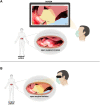Image-guided surgery and novel intraoperative devices for enhanced visualisation in general and paediatric surgery: a review
- PMID: 35937852
- PMCID: PMC9294338
- DOI: 10.1515/iss-2021-0028
Image-guided surgery and novel intraoperative devices for enhanced visualisation in general and paediatric surgery: a review
Abstract
Fluorescence guided surgery, augmented reality, and intra-operative imaging devices are rapidly pervading the field of surgical interventions, equipping the surgeon with powerful tools capable of enhancing the surgical visualisation of anatomical normal and pathological structures. There is a wide range of possibilities in the adult population to use these novel technologies and devices in the guidance for surgical procedures and minimally invasive surgeries. Their applications and their use have also been increasingly growing in the field of paediatric surgery, where the detailed visualisation of small anatomical structures could reduce procedure time, minimising surgical complications and ultimately improve the outcome of surgery. This review aims to illustrate the mechanisms underlying these innovations and their main applications in the clinical setting.
Keywords: augmented reality; fluorescence-guided surgery; general surgery; image-guided surgery; intra-operative visualisation; novel devices; optical imaging; paediatric surgery.
© 2022 Laura Privitera et al., published by De Gruyter, Berlin/Boston.
Conflict of interest statement
Competing interests: Authors state no conflict of interest.
Figures



References
Publication types
Grants and funding
LinkOut - more resources
Full Text Sources
Other Literature Sources
